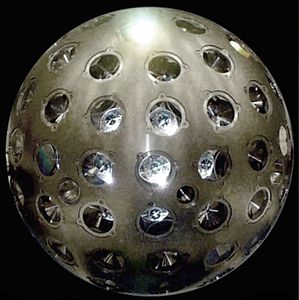LARES (satellite)
| LARES | |
|---|---|

|
|
| Type: | Research satellite |
| Country: |
|
| Operator: |
|
| COSPAR-ID : | 2012-006A |
| Mission dates | |
| Dimensions: | 387 kg |
| Size: | 36.4 cm in diameter |
| Begin: | February 13, 2012 |
| Starting place: | CSG , ELV |
| Launcher: | Vega |
| Status: | in orbit |
| Orbit data | |
| Track height: | 1450 km |
| Orbit inclination : | 69.5 ° |
The Laser Relativity Satellite ( LARES ) is a passive satellite of the Italian space agency ASI for the detection of the Lense-Thirring-Effect , a gravitomagnetic effect that results from the general theory of relativity .
functionality
The Lense-Thirring-Effect is an effect caused by gravitomagnetism, which causes that a rotating mass (here the earth) pulls the space-time around itself and thereby "twists" it. This has effects on the satellite orbit , which can be proven by precisely measuring the deviation of the actual position of the satellite from the position calculated using methods of classical physics . Since this effect is very small, a very precise measurement is necessary on the one hand, and interference from other sources such as air friction or interactions with the earth's magnetic field must be kept low, which is achieved through the choice of the orbit and the materials used. The position of the satellite is determined by ground stations using laser distance measurement with an accuracy of less than one centimeter. By combining the LARES measurements with measurements on the similarly structured satellites LAGEOS 1 and 2 and the models of the Earth's gravity field created by the GRACE satellites, it is expected that the Lense-Thirring effect can be measured with a measurement deviation of 1%.
construction
The completely passive spherical satellite consists of a tungsten - alloy (THA-18N) having a density of about 18,000 kg / m³ and reaches a diameter of only 36.4 cm a mass of 387 kg. The satellite body is made from a single piece. The surface of the sphere is covered with 92 laser reflectors for tracing the path. All other parts such as screws and brackets for the laser reflectors are made of the same alloy as that of the satellite body.
With a density of around 15,325 kg / m³, LARES is considered to be the object with the greatest mean density that moves its orbits in the solar system .
Since LARES does not have a conventional payload adapter due to its spherical shape, the upper stage of the rocket was provided with special equipment that secures the satellite during launch and can release it after reaching the target orbit. This A & H / SS (Avionic & Harness / Support System) device consists of a bearing shell for the satellite, four mechanical brackets that fix the satellite and release it later, as well as the associated control electronics.
mission
LARES was launched as the main payload on the maiden flight of the Vega rocket along with eight secondary payloads from the Center Spatial Guyanais spaceport in Kourou , French Guiana on February 13, 2012. The rocket deployed LARES 55 minutes after launch in a circular orbit at an altitude of 1,450 km.
Measurements for the primary mission should be carried out by 2016, but due to its stable orbit with a lifespan of more than 20,000 years and its passive construction, the satellite is practically unlimited available for later measurements.
Evaluations of the LARES measurement data provided the most accurate evidence of the Lense-Thirring effect to date. In addition to this main task, the satellite can also be used for measurements in the field of geodynamics and satellite geodesy .
With the follow-up mission LARES 2 , an even higher measurement accuracy is to be achieved. The launch of this satellite is planned for December 2020 with the maiden flight of the Vega-C rocket .
Web links
- LARES project website (Italian / English)
- LARES on the ASI website
- LARES in the eoPortal
- Ignazio Ciufolini et al .: LARES Laser Relativity Satellite (PDF; 1 MB)
- Antonio Paolozzi: LARES Satellite ( Memento from March 4, 2016 in the Internet Archive ) (PDF; 2 MB)
- LARES on Gunter's Space Page
- LARES-A & H / SS on Gunter's Space Page
Individual evidence
- ↑ a b c Ignazio Ciufolini et al .: LARES Laser Relativity Satellite (PDF; 1.1 MB)
- ↑ a b c eoPortal Directory: LARES (LAser RElativity Satellite)
- ^ The Science on the LARES project website
- ↑ LARES Mission on the LARES project website
- ↑ TEMIS: LARES A & H / SS ( Memento from April 12, 2013 in the Internet Archive )
- ↑ Italian satellite to help measure space-time warp in Spaceflight Now , February 10, 2012.
- ↑ ASI: LARES ( Memento of February 13, 2012 in the Internet Archive )
- ↑ Isidoro Peroni et al .: The Design of LARES: a Satellite for Testing General Relativity ( Abstract )
- ↑ LARES 2 Mission Lares 2 on the Lares project website, accessed March 2, 2020.
- ^ Launch Schedule. Spaceflight Now, accessed June 1, 2020 .